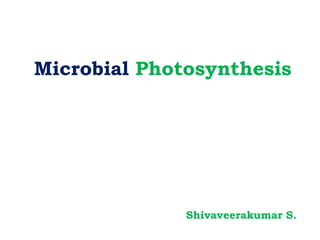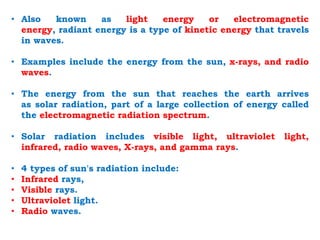Photosynthesis.pptx
- 2. THE SUN: MAIN SOURCE OF ENERGY FOR LIFE ON EARTH
- 3. Our Star, the Sun
- 4. The Sun is the Largest Object in the Solar System ŌĆó The Sun contains more than 99.85% of the total mass of the solar system ŌĆó If you put all the planets in the solar system, they would not fill up the volume of the Sun ŌĆó 110 Earths or 10 Jupiter's fit across the diameter of the Sun
- 5. The Sun goes through periods of relative activity and inactivity
- 6. The SunŌĆÖs interior has three layers: (1) Core (2) Radiative zone (3) Convective zone Energy generated in the core of the sun propagates outward through these different layers, and finally, through the atmosphere of the Sun. This process takes tens of thousands of years or more.
- 7. ŌĆó Like most stars, the sun is made up mostly of hydrogen and helium atoms in a plasma state. ŌĆó The sun generates energy from a process called nuclear fusion. ŌĆó During nuclear fusion, the high pressure and temperature in the sun's core cause nuclei to separate from their electrons. ŌĆó Solar energy is any type of energy generated by the sun. ŌĆó Solar energy is created by nuclear fusion that takes place in the sun. ŌĆó Fusion occurs when protons of hydrogen atoms violently collide in the sun's core and fuse to create a helium atom. ŌĆó Like the Earth, the sun has layers. But unlike the Earth, the sun is entirely gaseous; there is no solid surface. ŌĆó Sun provides two types of energy: Heat and Light.
- 8. ŌĆó Also known as light energy or electromagnetic energy, radiant energy is a type of kinetic energy that travels in waves. ŌĆó Examples include the energy from the sun, x-rays, and radio waves. ŌĆó The energy from the sun that reaches the earth arrives as solar radiation, part of a large collection of energy called the electromagnetic radiation spectrum. ŌĆó Solar radiation includes visible light, ultraviolet light, infrared, radio waves, X-rays, and gamma rays. ŌĆó 4 types of sun's radiation include: ŌĆó Infrared rays, ŌĆó Visible rays. ŌĆó Ultraviolet light. ŌĆó Radio waves.
- 9. ŌĆó The Sun's diameter is about 1.39 million kilometers (864,000 miles), or 110 times that of Earth. ŌĆó Its mass is about 3,30,000 times that of Earth, comprising about 99.86% of the total mass of the Solar System. ŌĆó Roughly three-quarters of the Sun's mass consists of hydrogen (~73%); the rest is mostly helium (~25%), with much smaller quantities of heavier elements, including oxygen, carbon, neon, and iron. ŌĆó The sun has extremely important influences on our planet. ŌĆó It drives weather, ocean currents, seasons, and climate, and makes plant life possible through photosynthesis. ŌĆó Without the sun's heat and light, life on Earth would not exist.
- 10. Sunlight or Energy of Sun: ŌĆó Improves your sleep. Your body creates a hormone called melatonin that is critical to helping you sleep. ŌĆó Reduces stress. ŌĆó Maintains strong bones. ŌĆó Helps keep the weight off. ŌĆó Strengthens your immune system. ŌĆó Fights off depression. ŌĆó Can give you a longer life. ŌĆó Deficiencies could increase the risk for osteoporosis, heart disease, some cancers, infectious diseases and even the flu.
- 11. ŌĆó Sunlight also helps our skin make vitamin D, which is needed for normal bone function and health. Yet sunlight can also cause damage. Sunlight travels to Earth as a mixture of both visible and invisible rays, or waves. Long waves, like radio waves, are harmless to people. ŌĆó Regular sun exposure is the most natural way to get enough vitamin D. To maintain healthy blood levels, aim to get 10ŌĆō30 minutes of midday sunlight, several times per week. People with darker skin may need a little more than this. Your exposure time should depend on how sensitive your skin is to sunlight.
- 12. ŌĆó Deficient of sunlight, all plants would die and, eventually, all animals that rely on plants for food ŌĆö including humans ŌĆö would die, too. ŌĆó While some inventive humans might be able to survive on a Sun-less Earth for several days, months, or even years, life without the Sun would eventually prove to be impossible to maintain on Earth. ŌĆó About 5 billion years, the sun will run out of hydrogen. Our star is currently in the most stable phase of its life cycle and has been since the formation of our solar system, about 4.5 billion years ago. Once all the hydrogen gets used up, the sun will grow out of this stable phase.
- 13. ŌĆó Almost all plants are photosynthetic autotrophs, as are some bacteria and protists ŌĆō Autotrophs generate their own organic matter through photosynthesis ŌĆō Sunlight energy is transformed to energy stored in the form of chemical bonds (a) Mosses, ferns, (b) and flowering plants (b) Kelp (c) Euglena (d) Cyanobacteria THE BASICS OF PHOTOSYNTHESIS
- 14. Light Energy Harvested by Plants & Other Photosynthetic Autotrophs 6 CO2 + 6 H2O + light energy ŌåÆ C6H12O6 + 6 O2
- 15. ŌĆó Photosynthesis is the process by which autotrophic organisms use light energy to make sugar and oxygen gas from carbon dioxide and water AN OVERVIEW OF PHOTOSYNTHESIS Carbon dioxide Water Glucose Oxygen gas PHOTOSYNTHESIS
- 16. ŌĆó The Calvin cycle makes sugar from carbon dioxide ŌĆō ATP generated by the light reactions provides the energy for sugar synthesis ŌĆō The NADPH produced by the light reactions provides the electrons for the reduction of carbon dioxide to glucose Light Chloroplast Light reactions Calvin cycle NADP’Ć½ ADP + P ŌĆó The light reactions convert solar energy to chemical energy ŌĆō Produce ATP & NADPH AN OVERVIEW OF PHOTOSYNTHESIS
- 17. Chloroplasts: Sites of Photosynthesis ŌĆó Photosynthesis ŌĆō Occurs in chloroplasts, organelles in certain plants ŌĆō All green plant parts have chloroplasts and carry out photosynthesis ŌĆó The leaves have the most chloroplasts ŌĆó The green color comes from chlorophyll in the chloroplasts ŌĆó The pigments absorb light energy
- 18. ŌĆó In most plants, photosynthesis occurs primarily in the leaves, in the chloroplasts ŌĆó A chloroplast contains: ŌĆō Stroma, a fluid ŌĆō Grana, stacks of thylakoids ŌĆó The thylakoids contain chlorophyll ŌĆō Chlorophyll is the green pigment that captures light for photosynthesis Photosynthesis occurs in chloroplasts
- 19. General Mechanism of Bacterial Photosynthesis ŌĆó Light-harvesting pigments (LHPs) embedded in membranes capture light energy and transfer it to a protein-complex called a reaction center ŌĆó The energy is converted into excited, low potential electrons ŌĆó Electrons are fed into an electron transport chain, where they "fall" through a series of electron carriers, generating a proton motive force (PMF) ŌĆó Membrane-bound ATPases then use the proton motive force to make ATP.
- 20. Classification of Photosynthetic Bacteria ŌĆó Five photosynthetic groups within domain Bacteria (based on 16S rRNA) ŌĆó Oxygenic Photosynthesis ŌĆō Cyanobacteria and Prochlorophytes ŌĆó Anoxygenic Photosynthesis ŌĆō Purple bacteria ŌĆō Green sulfur bacteria ŌĆō Heliobacteria ŌĆō Green gliding bacteria
- 21. Oxygenic Photosynthesis ŌĆó Occurs in Cyanobacteria and Prochlorophytes ŌĆó Synthesis of carbohydrates results in release of molecular O2 and removal of CO2 from atmoshphere ŌĆó Occurs in lamallae which house thylakoids containing chlorophyll a/b and phycobilisomes pigments which gather light energy ŌĆó Uses two photosystems (PS): - PS II- generates a proton-motive force for making ATP - PS I- generates low potential electrons for reducing power.
- 23. Anoxygenic Photosynthesis ŌĆó Uses light energy to create organic compounds, and sulfur or fumarate compounds instead of O2 ŌĆó Occurs in purple bacteria, green sulfur bacteria, green gliding bacteria and heliobacteria ŌĆó Uses bacteriochlorophyll pigments instead of chlorophyll ŌĆó Uses one photosystem (PS I) to generate ATP in ŌĆ£cyclicŌĆØ manner
- 24. Anoxygenic Photosynthesis Reduction potential: A tendency of a chemical species to be reduced by gaining an electron
- 25. ŌĆó Chloroplasts contain several pigments Chloroplast Pigments ŌĆō Chlorophyll a ŌĆō Chlorophyll b ŌĆō Carotenoids Figure 7.7
- 26. Chlorophyll a & b ŌĆóChl a has a methyl group ŌĆóChl b has a carbonyl group Porphyrin ring delocalized e- Phytol tail Phytol tail of chlorophyll is a long hydrocarbon chain that is hydrophobic in nature. It anchors the pigment to membranes of thylakoids. The hydrophobicity of the tail allows it to anchor the pigment to the membranes of thylakoids. Mg ion is present in the Porphyrin head.
- 27. Different pigments absorb light differently
- 28. Excited state e’ĆŁ Heat Light Photon Light (fluorescence) Chlorophyll molecule Ground state 2 (a) Absorption of a photon Excitation of chlorophyll in a chloroplast e’ĆŁ Photolysis of water: When the electrons leave the chlorophyll molecules, it leaves behind a 'hole.' This electron hole is filled in by a water molecule that is oxidized, or loses electrons, as it essentially splits into two hydrogen atoms, or protons, and an oxygen atom.
- 29. Cyclic Photophosphorylation ŌĆó Process for ATP generation associated with some Photosynthetic Bacteria ŌĆó Reaction Center => 700 nm
- 30. Water-splitting photosystem NADPH-producing photosystem ATP mill ŌĆó Two types of photosystems cooperate in the light reactions
- 31. Primary electron acceptor Primary electron acceptor Photons PHOTOSYSTEM I PHOTOSYSTEM II Energy for synthesis of by chemiosmosis Noncyclic Photophosphorylation ŌĆó Photosystem II regains electrons by splitting water, leaving O2 gas as a by-product
- 32. ŌĆó The O2 liberated by photosynthesis is made from the oxygen in water (H+ and e-) Plants produce O2 gas by splitting H2O
- 33. 2 H’Ć½ + 1/2 Water-splitting photosystem Reaction- center chlorophyll Light Primary electron acceptor Energy to make Primary electron acceptor Primary electron acceptor NADPH-producing photosystem Light NADP’Ć½ 1 2 3 How the Light Reactions Generate ATP and NADPH
- 34. ŌĆó Two connected photosystems collect photons of light and transfer the energy to chlorophyll electrons ŌĆó The excited electrons are passed from the primary electron acceptor to electron transport chains ŌĆō Their energy ends up in ATP and NADPH In the light reactions, electron transport chains generate ATP, NADPH, & O2
- 35. ŌĆó The electron transport chains are arranged with the photosystems in the thylakoid membranes and pump H+ through that membrane ŌĆō The flow of H+ back through the membrane is controlled by ATP synthase to make ATP ŌĆō In the stroma, the H+ ions combine with NADP+ to form NADPH Chemiosmosis powers ATP synthesis in the light reactions
- 36. The production of ATP by chemiosmosis in photosynthesis Thylakoid compartmen t (high H+) Thylakoid membrane Stroma (low H+) Light Antenna molecules Light ELECTRON TRANSPORT CHAIN PHOTOSYSTEM II PHOTOSYSTEM I ATP SYNTHASE
- 37. Review: Photosynthesis uses light energy to make food molecules Light Chloroplast Photosystem II Electron transport chains Photosystem I CALVIN CYCLE Stroma LIGHT REACTIONS CALVIN CYCLE Cellular respiration Cellulose Starch Other organic compounds ŌĆó A summary of the chemical processes of photosynthe sis
- 38. ŌĆ£DarkŌĆØ reaction (Light-independent Reaction) 6CO2 + 12H2O + light energy C6H12O6 + 6O2 + 6H2O ŌĆó ŌĆ£DarkŌĆØ reaction: Calvin cycle ŌĆó regenerative ŌĆó anabolic ŌĆó CO2 in, sugar out ŌĆó during daylight CO2 NADP+ ADP Pi + RuBP 3-Phosphoglycerate Calvin Cycle G3P ATP NADPH Starch (storage) Sucrose (export) Chloroplast Light H2O O2
- 39. Carbon fixation ŌĆó 3 stages of Calvin- cycle: ŌĆó #1 ŌĆō carbon fixation ŌĆó CO2 link to 5-C ŌĆó 5-C: ribulose bisphosphate (RuBP) - enzyme: Rubisco abundant ŌĆó 6-C unstable ŌĆō split ’āĀ 2(3-C)
- 40. Reduction ŌĆó #2 ŌĆō reduction ŌĆó reduced 3-C: G3P ŌĆó 3-C reduced ŌĆó e- from NADPH ŌĆó 3 stages of Calvin- cycle:
- 41. Regeneration of C-acceptor ŌĆó multiple steps ŌĆó uses ATP ŌĆó every 3 cycles: 1 G3P made 3 RuBP regenerated ŌĆó #3 ŌĆō regenerate C- acceptor ŌĆó still 5 G3P ’āĀ 3 RuBP ŌĆó C3 plants ŌĆō CO2 fixed into 3-C ŌĆó 3 stages of Calvin- cycle:








































